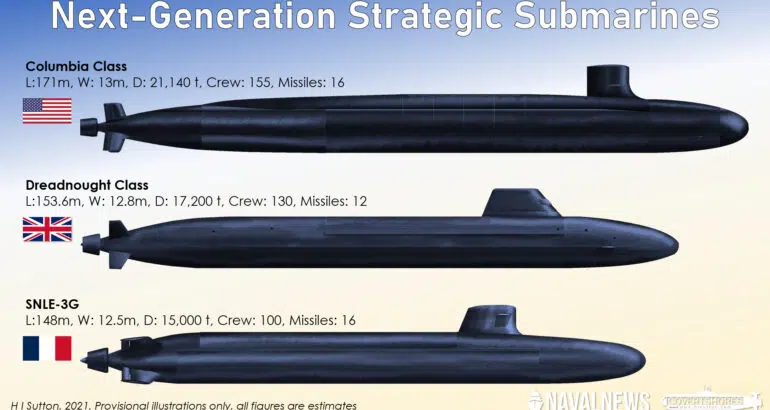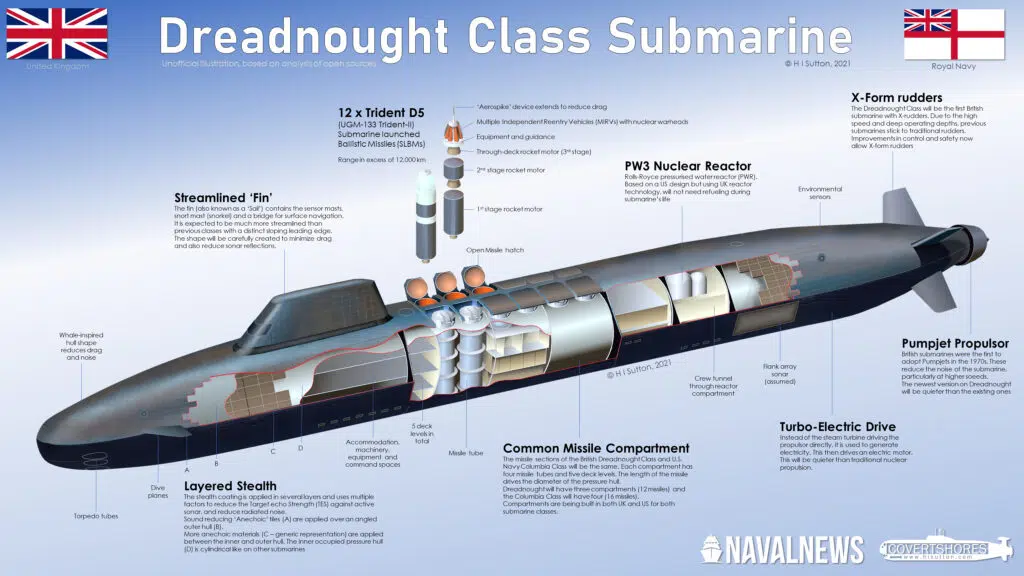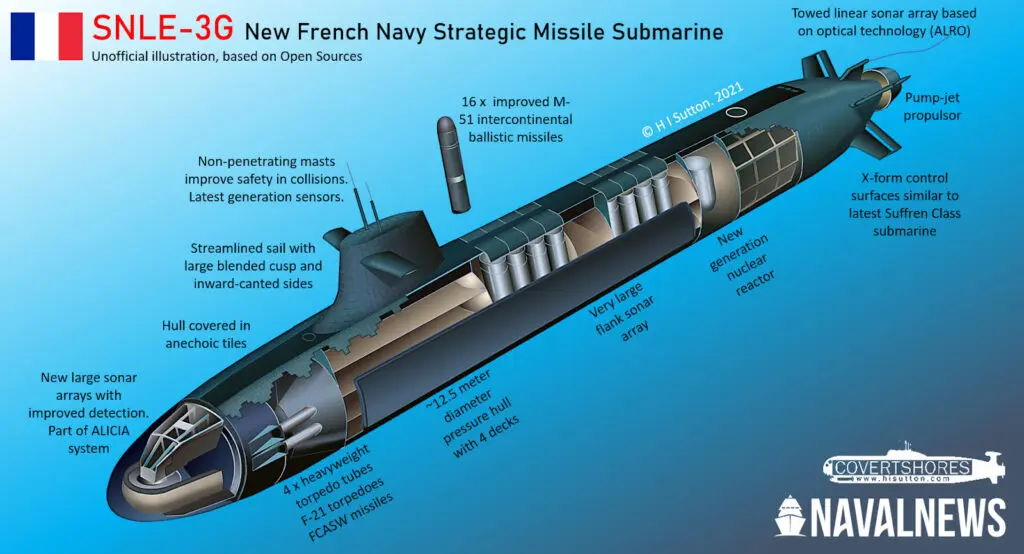 New Submarines Compared: Columbia Class, Dreadnought Class And SNLE-3G
New Submarines Compared: Columbia Class, Dreadnought Class And SNLE-3G
Ballistic Missile Submarines (SSBNs) form the backbone of nuclear deterrents. Yet the types in service with NATO navies, the U.S., U.K., and France, are reaching the ends of their service lives. The new submarines which are being built to succeed them should keep the deterrent dependable in an uncertain future.
H I Sutton 24 Nov 2021
While Russia is already pumping out its latest Borei-II class ballistic missile submarines (SSBNs), the equivalent boats in service with the US Navy and Royal Navy are towards the end of their lives. And France’s too, while more recent, will also need replacement in the coming years. So Western navies are already working on the replacements.
There are corresponding next generation strategic submarine projects in the United States, Britain, and France. How do the new boats compare?
The ProjectsThe current US boats were introduced at the end of the 1970s, while the British ones came in the early 1990s. And the French boats in the late 90s. Because the three countries have historically launched their SSBNs at different times, the replacement cycle does not usually aligned. That has changed, in part because the current boats have been kept in service longer than intended. But we now have the three countries designing comparable boats at the same time.
In the U.S. Navy the current Ohio Class SSBN will be replaced by the Columbia (SSBN-826) Class from the 2030s. Meanwhile the first of the Royal Navy’s Dreadnought Class submarines, which will replace the current Vanguard Class, has already been started. The Vanguards are newer than the Ohios and already feature modern features such as pump-jet propulsion. France has started the SNLE-3G (Sous-marin nucléaire lanceur d’engins – 3rd generation) to succeed the current Triomphant class.
All three new designs share many aspects in common. Externally, x-form rudders and the latest pump jets for example. On the inside they are likely to share many sensitive technologies too. But there are some major differences in the overall designs.
Counting Missiles

At about 171m the Columbia class will be about the same length as the Ohio Class SSBNs, or a touch longer. This is despite carrying fewer ballistic missiles. Originally the Ohios each carried 24 Trident SLBMs (submarine launched ballistic missiles) but this has been reduced to 20 by deactivating four of the tubes in situ. The reduction to 16 missiles is a return to the pre-Ohio days, and is primarily driven by cost. However, it also reflects more current deterrence calculations. Fundamentally the Trident force must have enough submarines, each with enough missiles, to guarantee an unacceptable loss on any would-be nuclear aggressor. That is the minimum deterrence. The U.S. Navy believes that 12 boats with 16 missile tubes each will be enough to provide a credible deterrent into the future.
When they are launched the Columbias will carry the same Trident D5 missile as the current Ohios. The plan it to replace this with a successor missile from the 2040s.
The British Dreadnought class will also carry fewer missiles than the current Vanguard class, with 12 instead of 16. And for operational reasons the actual load may be fewer in practice.
The missiles and the corresponding missile compartments are closely related between the U.S. and British boats. There is increasing collaboration between America and Britain. There has always been a special relationship, with submarine technology flowing both ways. The Columbia and Dreadnought Classes will take this to new levels. They will share key components in the reactor and machinery spaces. And the missile sections, which largely dictate the size of the boat, will be a common build. Essentially think of these as being the same boat in the middle, with each country adding their own forward hulls and trimmings.
The new common missile modules are built in sets of four missile tubes. So the Colombia Class will have four sets (16 missiles) and the Dreadnought three (12 missile tubes).
The French SNLE-3G is also already under development. Unlike the American and British designs it will retain the same number of missile silos as the current Triomphant class. This has 16 tubes and is armed with the latest M51 SLBM.
The SNLE-3G is expected to leverage technology from the latest Suffren Class attack submarine. Because of the size of the missiles the hull will have to be larger, it cannot be simply a modified Suffren.
Stealthier boats

Not unsurprisingly all three boats will be stealthier than the current types. For the American and British designs, new nuclear reactors coupled with turbo-electric drive will further reduce radiated noise. This requires more space however, so the boats are growing in size and displacement despite carrying fewer missiles.
The most noticeable stealth features will be on the British boat. The Dreadnought class is likely to include the angled outer hull shape which Britain has been quietly evolving for 30 years or more. Not much talked about, this angled stealth has become better known thanks to the German Type-212CD design. But British designers have been incorporating it, to varying degrees, for a while. The visible clue will likely be a long chine running along the sides with slab-like hull lines above and below.
The French boat will also feature improved stealth. France is already known for its system of raft-mounting the machinery to reduce noise. Added to this will be new noise-reduction anechoic tiles on the outside of the hull, similar to those already seen on British designs.
Other Navies Join The Nuclear Game
All three new designs promise to be incredibly capable platforms. They will be worthy successors to the Ohio, Vanguard and Triomphant classes. They are different; American and French designs will carry more missiles, wile the British design as the most obvious emphasis on new stealth technologies. But the bigger takeaway is that they are also in many ways similar, more so than in previous generations. The US and British designs in particular even share many components.
By the time they enter service, Russia’s Borei-II will be the ones which look dated. Still effective, but half a generation older. Russia however has a trick up its sleeve which will change the shape of its nuclear deterrent. As well as ballistic missile submarines, it is building a whole new category of nuclear armed submarines. Carrying the Poseidon intercontinental nuclear powered autonomous torpedo, these will have no analogue in the West.
And the at-sea detergent landscape is becoming more crowded. China too is building a new generation of SSBN, although specific details are still sketchy. And India too. Meanwhile North Korea’s conventionally powered missile subs are likely to become more potent, and other countries will be fielding nuclear armed cruise missiles.
https://www.navalnews.com/naval-news/20 ... d-snle-3g/



